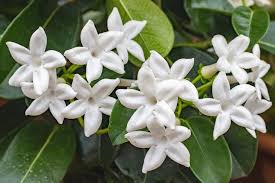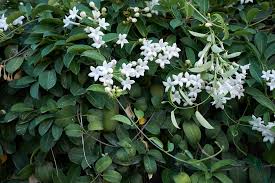Stephanotis flowers, scientifically known as Stephanotis floribunda, are a breathtaking example of nature’s elegance and charm. These delicate, star-shaped blooms have captured the hearts of flower enthusiasts around the world with their ethereal beauty and enchanting fragrance. Commonly referred to as “Madagascar Jasmine” or “Bridal Veil,” the stephanotis flower is cherished for its ability to symbolize purity, marital happiness, and everlasting love.
Stephanotis floribunda is a species of flowering vine belonging to the family Apocynaceae. This perennial plant is native to Madagascar, an island country located in the Indian Ocean, but is now widely cultivated in various tropical and subtropical regions. The vine produces glossy, deep green, leathery leaves that serve as a stunning backdrop for the pure white, waxy flowers.
One of the most captivating aspects of the stephanotis flower is its unique appearance. The flowers typically measure around 1 to 2 inches in diameter and are composed of five pointed petals arranged in the shape of a star. This striking formation lends an otherworldly charm to the blossoms, making them an ideal choice for bridal bouquets, corsages, and floral arrangements for special occasions.
Perhaps the most alluring characteristic of the stephanotis flower is its sweet, intoxicating fragrance. The blossoms emit a heavenly scent, especially during the late afternoon and evening hours, to attract pollinators such as moths and butterflies. The fragrance is so captivating that it has been incorporated into various perfumes and scented products.
While the stephanotis flower possesses an air of sophistication, caring for this lovely vine is relatively simple. To flourish, it requires a warm and sunny environment, making it an ideal choice for indoor gardening in cooler climates. Adequate sunlight, well-draining soil, and a trellis or support structure for the vine to climb on are essential for its healthy growth.
Watering the stephanotis plant should be done moderately, ensuring the soil remains evenly moist but not waterlogged. Regular pruning is recommended to maintain its shape and promote flowering. Fertilizing the plant during the growing season will encourage vibrant blooms and lush foliage.
Stephanotis flowers have long held special meanings in different cultures. In some traditions, the blooms symbolize marital bliss and happiness, making them a popular choice for wedding ceremonies and anniversaries. The gentle beauty and pure white hue of the stephanotis flowers also represent innocence and sincerity, making them a favored gift to convey heartfelt emotions.
Stephanotis, with its resplendent star-shaped flowers and heavenly fragrance, remains a timeless symbol of beauty, love, and purity. Whether adorning a bride’s bouquet or gracing a trellis in a home garden, the allure of this exquisite flower continues to captivate people’s hearts. Embracing the elegance of stephanotis is not only a celebration of nature’s wonders but also a testament to the profound emotions that flowers can evoke in the human soul.
History and Significance of Stephanotis Flowers

Stephanotis flowers, scientifically known as Stephanotis floribunda, have a rich history and hold significant cultural and symbolic meanings. Originating from the island of Madagascar, these enchanting blooms have traveled the world and left a lasting impression on various civilizations.
Stephanotis flowers have been cherished for centuries, and their history can be traced back to their native land, Madagascar. The native Malagasy people valued the plant not only for its beauty but also for its medicinal properties. Traditional healers used parts of the plant to create remedies for skin ailments, insect bites, and other minor health issues. The allure of the Stephanotis flower soon captured the attention of European explorers and botanists, leading to its introduction to the European continent in the early 19th century.
During the Victorian era in the 19th century, flower symbolism became a popular way of expressing emotions and sentiments. Stephanotis flowers, with their pure white color and heavenly fragrance, were highly favored for their symbolism of marital happiness and fidelity. They were commonly used in bridal bouquets, and their presence at weddings represented the hope for a long and harmonious marriage. The flower’s star-shaped petals were associated with the idea of celestial beauty and the guidance of the stars in a couple’s journey through life together.
Stephanotis flowers have gained cultural significance in various regions around the world. In some cultures, the flower is considered a symbol of good luck and prosperity, and it is believed to bring blessings to the newlyweds. In addition to its connection to marriage, the Stephanotis flower has also been associated with purity, love, and spiritual growth, making it a popular choice for religious ceremonies and festivals.
Beyond their cultural and symbolic meanings, Stephanotis flowers have earned their place in the hearts of gardeners and horticultural enthusiasts. Their climbing nature and elegant appearance make them a prized ornamental vine, adorning trellises, pergolas, and arbors in gardens and landscapes. In regions with suitable climates, they have become a favored choice for adding a touch of exotic beauty to outdoor spaces.
Given their native origin in Madagascar, Stephanotis flowers face challenges due to habitat destruction and environmental changes. As awareness of biodiversity conservation increases, efforts are being made to protect and preserve the natural habitats of these plants and other species found in Madagascar.
In summary, Stephanotis flowers have a history deeply rooted in their native land of Madagascar, and their allure has spread across continents over time. Their significance in various cultures, particularly in relation to weddings and love, has solidified their position as a symbol of beauty, purity, and spiritual growth. Today, they continue to enchant admirers with their celestial appearance and captivating fragrance, reminding us of the enduring connection between nature and human emotions.
Read Also: 9 Ways to Fatten Up your Pigs the Right Way
Uses of Stephanotis Flowers

Stephanotis flowers, with their beauty and alluring fragrance, have found numerous uses and applications across different aspects of human life. From cultural ceremonies to therapeutic practices, here are some of the key uses of Stephanotis:
1. Ornamental Purposes: One of the primary uses of Stephanotis is for ornamental purposes. The exquisite white star-shaped flowers and glossy green foliage make it a popular choice for gardens, landscapes, and indoor spaces. The vine’s climbing nature allows it to be trained on trellises, fences, and walls, adding a touch of elegance to any setting.
2. Bridal Bouquets and Corsages: Stephanotis flowers have a significant association with weddings and love. They are often used in bridal bouquets and corsages, symbolizing marital happiness, purity, and fidelity. Their presence in wedding arrangements adds a touch of sophistication and timeless beauty to the occasion.
3. Aromatherapy and Fragrance: The sweet and heady fragrance emitted by Stephanotis flowers makes them a favorite in aromatherapy. The scent is believed to have calming and soothing effects on the mind, helping to reduce stress and promote relaxation. Essential oils and scented candles derived from Stephanotis flowers are used to create a calming ambiance in homes and spa environments.
4. Traditional Medicine: In the plant’s native region, Madagascar, certain parts of the Stephanotis plant have been used in traditional medicine. Past remedies derived from the plant were applied to treat various skin conditions, insect bites, and minor ailments. However, it’s important to note that some parts of the plant can be toxic if ingested, so caution must be exercised.
5. Floral Crafts and Decorations: The elegant appearance and long-lasting nature of Stephanotis flowers make them a favorite in floral crafts and decorations. They are used in flower arrangements, centerpieces, and floral wreaths, adding a touch of sophistication and charm to special events and celebrations.
6. Religious and Ceremonial Uses: In some cultures, Stephanotis flowers hold religious significance and are used in ceremonies, rituals, and festivals. Their association with purity and spiritual growth makes them appropriate for various sacred occasions.
7. Symbolic Gifts: Stephanotis flowers are sometimes used as symbolic gifts to express love, appreciation, and good wishes. A bouquet of these beautiful blooms can convey heartfelt emotions and serve as a thoughtful present for loved ones on special occasions.
8. Botanical Research: From a scientific perspective, Stephanotis floribunda is of interest to botanists and horticulturists. Studying the plant’s growth patterns, pollination mechanisms, and adaptation to different climates helps advance our understanding of plant biology and contributes to horticultural knowledge.
Overall, the uses of Stephanotis flowers extend far beyond their aesthetic appeal. Whether adorning wedding ceremonies, providing aromatic benefits, or contributing to floral arrangements, these captivating blooms continue to hold a special place in human culture and our appreciation for the beauty of nature.
Read Also: The Different Crop Storage Methods
Complete Growing and Care Guide of Stephanotis Flowers

1. Climate and Location:
Stephanotis thrives in warm and tropical climates. If you live in a region with mild winters, you can grow the plant outdoors. For areas with colder winters, consider growing Stephanotis in a greenhouse or as a houseplant that can be moved outdoors during warmer months.
2. Sunlight:
Provide your Stephanotis plant with bright, indirect sunlight. It prefers partial shade, especially during the hottest hours of the day. Avoid exposing the plant to direct sunlight for extended periods, as it can scorch the leaves.
3. Soil:
Use a well-draining and fertile soil mix for Stephanotis. A combination of peat moss, perlite, and sand is ideal. The soil should retain moisture but not become waterlogged.
4. Watering:
Keep the soil consistently moist but not soggy. Water the plant thoroughly when the top inch of soil feels dry to the touch. During the growing season (spring and summer), Stephanotis may require more frequent watering. Reduce watering during the dormant winter months.
5. Humidity:
Stephanotis thrives in high humidity environments. If you live in a dry climate or during the winter when indoor heating reduces humidity, mist the leaves regularly or use a humidity tray near the plant to maintain adequate moisture levels.
6. Fertilizer:
Feed your Stephanotis with a balanced liquid fertilizer every 2-4 weeks during the growing season (spring and summer). Follow the manufacturer’s instructions for proper dilution and application.
7. Pruning:
Regular pruning is essential to control the growth of Stephanotis and promote bushier, healthier foliage. After the plant has finished flowering, trim back the long shoots to maintain the desired shape and size.
8. Trellis or Support:
Stephanotis is a climbing vine, so provide it with a trellis or other support structure to guide its growth. Secure the stems gently to the support to encourage upward growth.
9. Repotting:
Young Stephanotis plants may need repotting every year, while mature ones can be repotted every 2-3 years. Choose a slightly larger pot with good drainage and fresh soil during repotting.
10. Propagation:
Stephanotis can be propagated through stem cuttings. Take 4-6 inch cuttings from the tip of healthy stems during the growing season. Remove the lower leaves and plant the cuttings in a well-draining rooting medium. Keep the soil consistently moist until new growth appears.
11. Pest and Disease Control:
Keep an eye out for common pests like aphids, mealybugs, and spider mites. Regularly inspect your plant and treat infestations with insecticidal soap or neem oil. Preventive measures such as maintaining good hygiene and providing proper air circulation can help deter pests and diseases.
12. Winter Care:
During the dormant winter period, reduce watering and avoid fertilizing. Place the plant in a slightly cooler location to encourage rest. If you’re growing Stephanotis indoors, ensure it receives enough indirect sunlight even during the winter months.
By following this growing and care guide, you can cultivate a healthy and thriving Stephanotis plant that will reward you with its stunning flowers and delightful fragrance for years to come. Remember that each plant is unique, so observe and adjust your care routine based on the specific needs of your Stephanotis to ensure its optimal growth and well-being.
